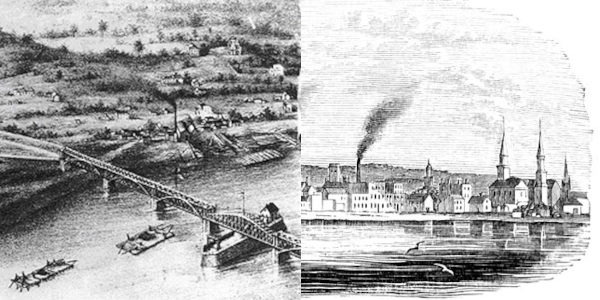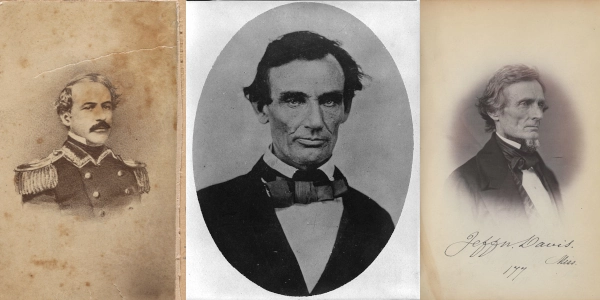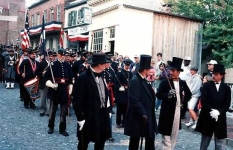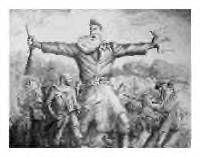Sponsor this page. Your banner or text ad can fill the space above.
Click here to Sponsor the page and how to reserve your ad.
-
Timeline
Detail - 1856
April 21, 1856 - The first railroad train crosses the Mississippi River on the first bridge constructed at Rock Island, Illinois to Davenport, Iowa.

Transportation, on both road and rail, was heading west. But the major obstacle to those traveling across the Mississippi River was the slow use of ferries. So it was time to build a bridge, and that bridge would start at Rock Island, Illinois over to Davenport, Iowa. But why was this location its choice? And how did they get from idea to completion before the first train could cross on April 21, 1856.
Until 1854, there had been no rail transporation that connected the east all the way to the Mississippi River, but the Chicago and Rock Island Railroad, under Henry Farnum and Joseph Sheffield, had begun the project west from Chicago in 1852, reaching Rock Island on February 22, 1854. Rock Island was chosen because this area had youthful rapids, was rather narrow, ran east to west, and had the limestone actual Rock Island in its center to use as a stepping stone. In an area today known as the Quad Cities, there were then Rock Island and Moline, Illinois on the east side, and Davenport, Iowa on its west. One addition plus was the already established, as of 1816, of Fort Amstrong on the southern end of Rock Island itself.
Above the fort was a protrusion from the island named Trader's Rock where Colonel George Davenport watched for customers on the river to his trade cabin nearby, and later a house which still stands. This rock would be the basis for the bridge. The Rock Island Rapids had been surveyed by Robert E. Lee in 1837. Fort Amstrong had been decommissioned and land plus a house had been donated in the Iowa side in Davenport by Antoine LeClaire. The house would be the first railroad depot in Davenport, and the railroad there, the Mississippi and Missouri, had ties to the Rock Island Railroad and the Railroad Bridge Company. The construction would be done by that separate entity, the Railroad Bridge Company, using John Warner and Company as contractors, and had been chartered expressly for this purpose by the Illinois legislature. The Bridge Company purportedly began construction on July 16, 1853; there are drawings of its design done in December 1854.

Construction and Use of the Bridge
The construction itself would take little over one year with the structure made almost entirely of wood. The bridge would use the Howe Truss system of design with long wooden trusses anchored to piers. There would be three trusses from Illinois onto Rock Island, and six trusses reaching over the Mississippi River from Rock Island to Davenport, Iowa. There were five fixed spans, with flat tops, each about 250' in length. The swing span, at 286', was in the middle of the Davenport section, longest in the world at the time, and located near the center of the Mississippi River.
Four months prior to the completion of the bridge, the Mississippi and Missouri Railroad finished its section from Davenport to Iowa City on December 31, 1855. On April 21, 1856, the bridge was ready to take its first train across. The citizens of Rock Island and Davenport came out and cheered its accomplishment as three steam locomotives with eight passenger cars safely crossed the newly christened Chicago and Rock Island Railroad Bridge. You could now travel to eastern Iowa from New York City in forty-two hours.

First Bridge History
The bridge lasted ten years, until another was built to replace it in 1866. There were mishaps from the beginning. Two weeks after its first use, May 6, 1856, the steamboat Effie Afton crashed into the bridge, and burned the boat and one span. It took four months to repair the bridge. The ship company sued the bridge three times after that, claiming it a hazard to navigation.
Shipping companies had been against the bridge in the first place; they saw rail as its competition and favored north to south transportation, while the railroads were going east to west. The federal government didn't like the bridge idea, with Secretary of War Jefferson Davis not in favor because he wanted a southern route for an eventual transcontinental line. He ordered the bridge halted; they did not. He got an injuction; Davis lost the case. In its most famous trial, Hurd vs. Rock Island Railroad in September 1857, Abraham Lincoln defended the railroad, who contended that the steamboat had tried to damage the bridge intentionally and caused the collision. He was an experienced railroad lawyer, working for the Illinois Central in the past. The trial lasted fourteen days. Lincoln eloquently made his case, and a hung jury allowed the railroad to continue using the bridge.
In 1858, the railroad would haul twelve thousand five hundred and eight-six freight cars and seventy-four thousand one hundred and seventy nine passengers across the bridge. The steamboat company was still not satisfied; they appealed the case to the Supreme Court, which upheld the original decision in 1872.
In 1863, the land on Rock Island around the bridge was used as a Union prison camp. Over ten thousand Confederate soldiers were held there over one and one half years. Three years later, the original bridge was considered insufficient, and a new bridge was built. Although the bridge is long gone, a monument on Rock Island (also called Arsenel Island) was built to commemorate it.
Image above: Montage (left) original Rock Island Bridge, Davenport side, 1800s, unknown author. Courtesy riveraction.org via Wikipedia Commons; (right) Rock Island, Illinois, 1865, Barber and Howe. Courtesy Wikipedia Commons. Below: Montage of three men involved in the fight over the Rock Island Bridge, who would later battle again in the Civil War (left) Portrait print of Robert E. Lee, Corps of Engineers, 1846, E. Anthony; (center) Photo of Abraham Lincoln, 1858, Calvin Jackson; (right) Portrait print of Jefferson Davis, 1859, Julian Vannerson. All courtesy Library of Congress. Info source: "A Pictorial History of the of the first Railroad Bridge across the Mississippi River and its three successors," Curtis C. Roseman, riveraction.org; "Bridging the Mississippi," 2004, David A. Pfeiffer, Prologue Magazine, National Archives; Wikipedia Commons.





